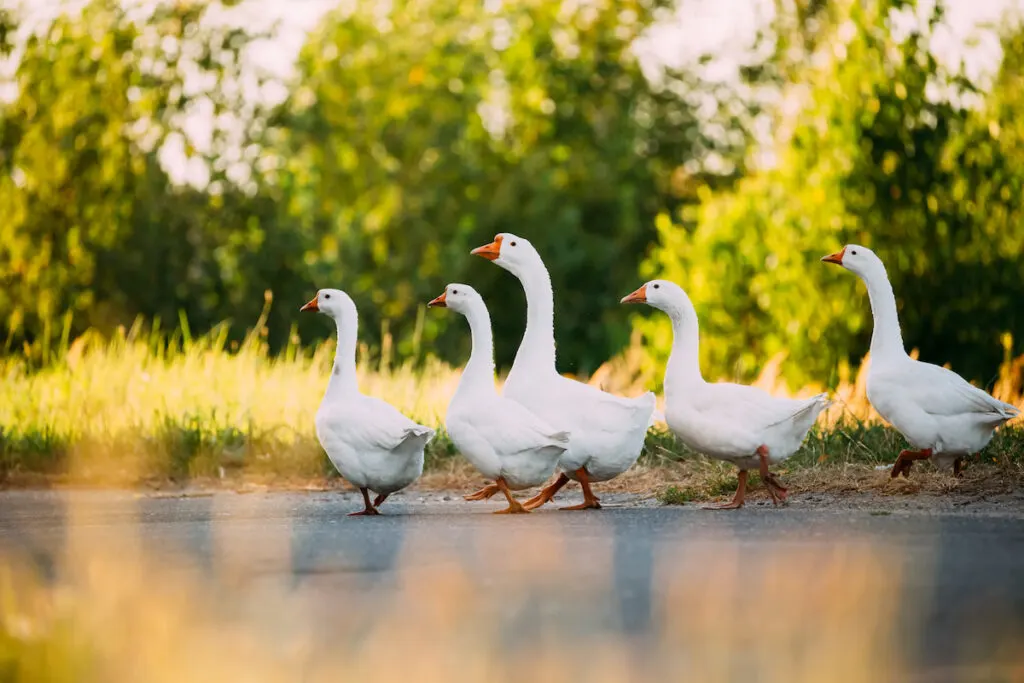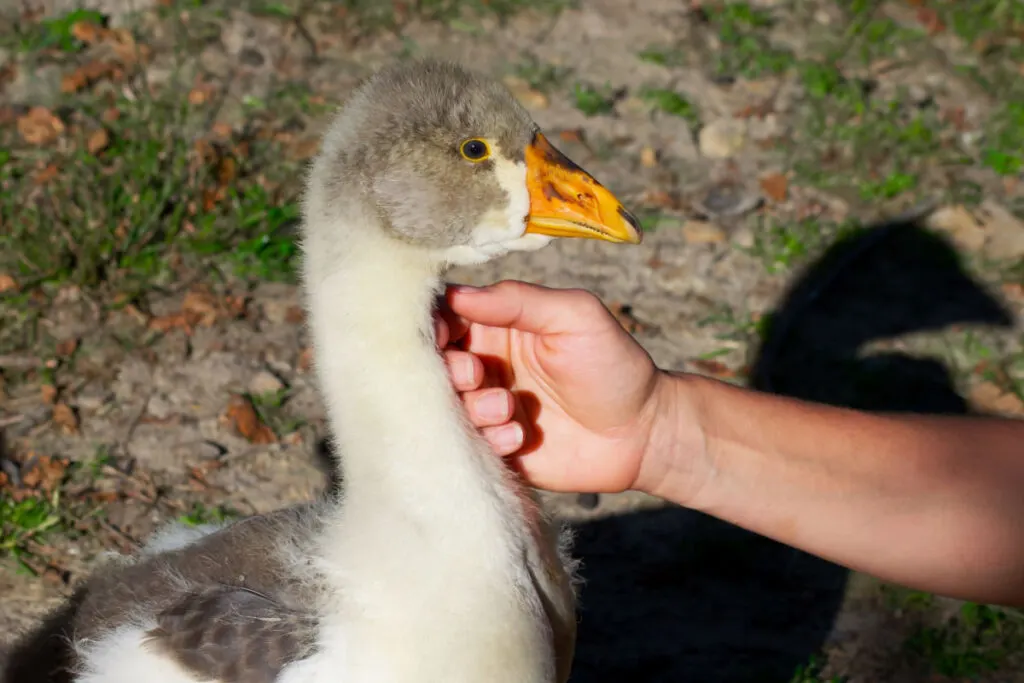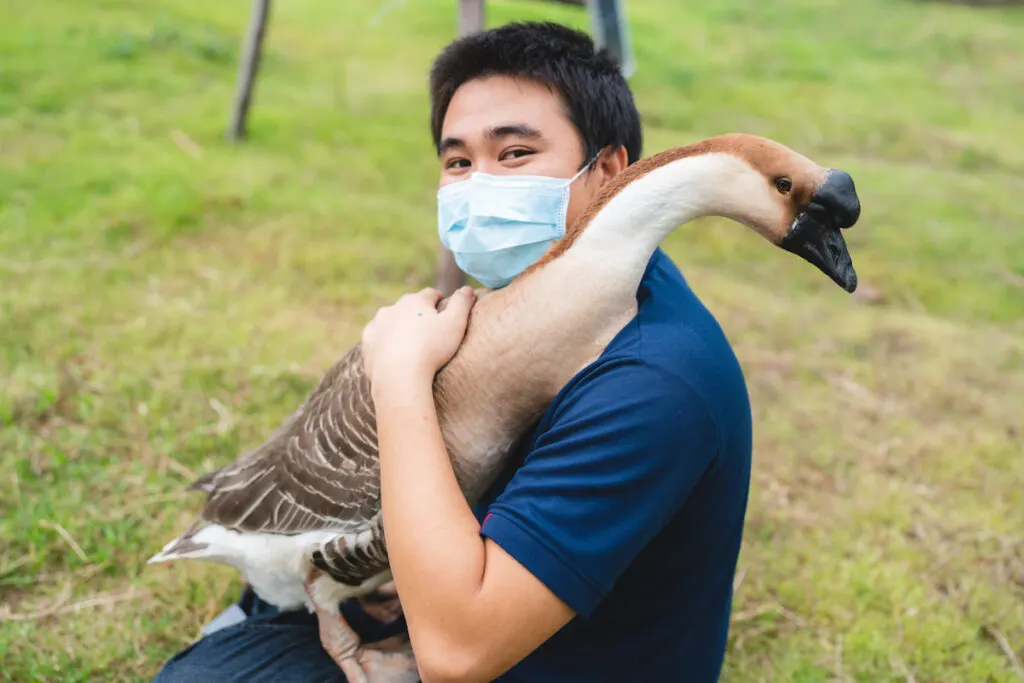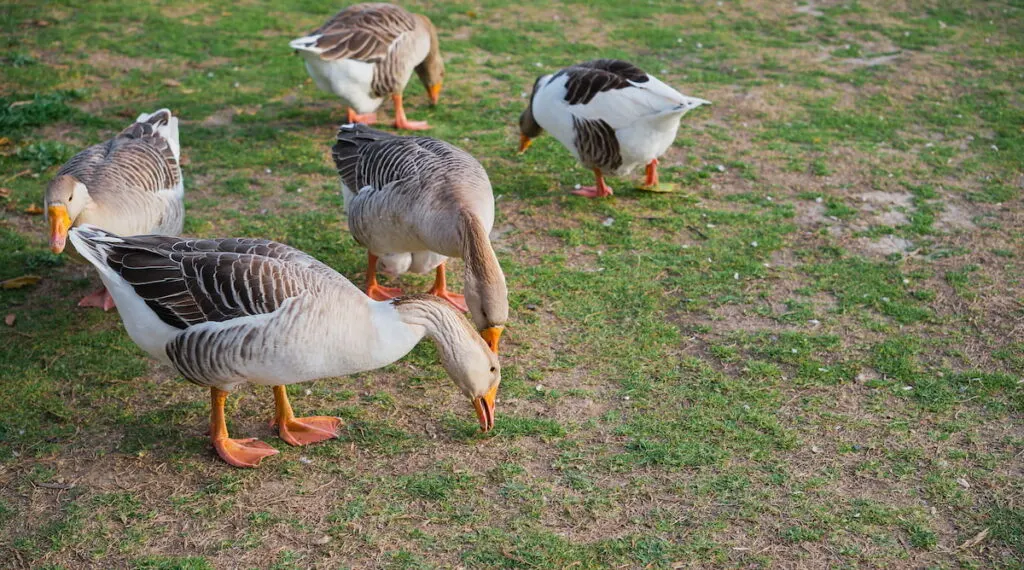Geese are impressive creatures, and while it’s true that they can be intimidating at times, they are generally peaceful animals.
Once domesticated, geese make excellent pets and offer advantages no other animal can match.
After time and with kind, caring attention, it’s highly likely that a goose will grow very fond of you and happily follow you around while showing you affection.
It’s amazing to see how beautiful and majestic these animals are. They are so much fun to observe and listen to, and their silly antics can be quite amusing!
Read on if you’re curious about the best ways to pet a goose or form a friendship with one. Let’s dive in and learn more about these fascinating birds!

Table of Contents
Is It Possible to Pet a Wild Goose?
You should never pet a wild goose. It’s always better to admire wild geese from a safe distance.
Due to their strong sense of territory, geese are known to aggressively pursue and even attack humans who encroach on their natural habitat.
You need to be aware that geese are large, powerful birds that, when provoked, can cause serious harm.
Geese are great parents who prioritize the safety of their eggs and goslings. They are always ready to defend their young ones if they sense any danger.
Fortunately, by maintaining a safe distance and showing respect for their space, you can easily appreciate the beauty of these creatures without encountering any problems.
Guidelines for Approaching a Domestic Goose
When approaching a goose, it’s important to remember that they are easily scared, but with a calm approach, you can peacefully coexist with them.
Avoid chasing or sneaking up on them. They may feel threatened and start avoiding you out of fear.
Geese are more likely to want to hang out with you if you go down to their level and give them a small piece of food or a treat.
But be aware that more nervous geese may pinch, scratch, or even attack with their powerful wings if you try to touch them.
It is recommended that, when spending time with these birds, you dress in layers or more robust clothing. Taking safety measures is always recommended.
But with a bit of patience and gentle encouragement, even the most nervous geese can be successfully handled.

Always Seek Approval Before Acting
When approaching an animal that is not your own, it is important to remember the golden rule: always ask for permission first.
Keep in mind that geese are large birds, and, despite their generally amiable demeanor, some of them can be aggressive.
That’s why you should always ask before touching a pet you don’t know.
You should also consult the owner for advice on how to approach the animal and pet it to ensure the experience is fun and safe.
Goose Petting Introduction
Have you ever heard of bird patting? This method involves gently massaging the bird’s skin with the tips of your fingers. It’s a peaceful method to connect with your winged companions and establish a positive relationship with them.
There are plenty of spots on your bird that you can safely touch without causing any stress.
These birds typically respond favorably when you pet them on the back, head, and neck.
To avoid stressing your pet, it is recommended that you avoid touching its tail, beak, and feet.
After you have developed a trustworthy relationship with your goose, it’s possible that it will enjoy being petted in almost any spot.
Naturally, there are variations among geese. Your pets have personalities and interests of their own, and you shouldn’t try to change that.

Perfect Petting Spots
Head. Geese enjoy having their heads scratched and petted. Simply place your finger gently on top of the goose’s head, then slowly run your fingers through the feathers.
Neck. Geese adore having their necks petted just as much as their heads. A light touch and a gentle wiggle will give your goose real pleasure.
Back. Most geese tend to enjoy being petted on their upper bodies. Simply placing your hand on the feathers of your goose and moving it slowly will do the trick.
Wings. Some geese don’t like it when people touch their wings, but others don’t mind at all.
Simply rest your hand on your bird’s wing without trying to move or spread it. Pet it gently.
How to Pick Up a Goose Safely?
First, calmly and steadily lead the geese to an area where they can’t move around too much. For instance, a corner enclosure would be ideal.
When you are close enough to safely reach the goose, place one hand on either side of its body. Try to keep it from flapping its wings by holding it close to you.
When the bird is held up, its legs may be free to move. The most important thing you can do when picking up a big bird like a goose is to wrap your arms around it and make it feel secure.
A goose should never be picked up by the neck, wings, legs, or feathers. This is a very dangerous and unacceptable method that puts the goose’s health at great risk and should be avoided.
Another potentially dangerous behavior for a goose is to catch its body under its wings.

Are Geese Easy to Care for?
Raising geese is simple. Geese are very robust in cold conditions and are resistant to many illnesses and parasites that affect other poultry.
According to the experts, geese should have between 6 and 8 square feet of space per bird in their coop.
A simple shed with enough windows and doors to keep it from getting too hot would be a good, safe, and comfortable place for them to live.
A basic enclosure designed to keep predators out will do for a run.
Clipping goose feathers may be necessary if you don’t want them to take off. Even a three-foot fence will do the job for birds that can’t fly.
Aside from the clean water and nourishment you give them, their primary diet will consist of the grass and insects they find in the area around them.
The average lifespan for geese is 10–15 years with proper care. On the other hand, some people are said to have had geese that lived for more than 40 years.
Due to the fact that geese are prey species, the primary factor responsible for their deaths is typically predators.
Therefore, protecting your waterfowl from predators should be your top priority if you want them to have a long and healthy life.
When It Comes to Controlling Pests in Your Garden, Geese Are Excellent Allies
When it comes to their diet, geese aren’t picky. Geese can survive and even flourish on a diet consisting solely of vegetation, insects, grass, and water. The only requirement is that the enclosure be large enough to suit their foraging needs.
Geese are omnivores that consume significant numbers of worms, including those that cause damage to crops, garden plants, or even people.
If you’re bothered by mosquitoes at night during the summer, you can get rid of them just by having a few geese. Therefore, if you have a mosquito problem in the area, raising a flock will drastically reduce the mosquito population.
The grass and weeds in inaccessible areas of your yard and any dropped fruit in the orchard are all fair game for geese.
Geese are also useful in limiting the spread of aquatic weeds. Plants like duckweed and algae that thrive in pools and lakes are a common food source for them.

Final Thoughts
A flock of geese can be a great option if you’re looking for a social, intelligent, and pest-controlling companion for your yard.
As an added bonus, these large water birds can become wonderful buddies and joyful friends if raised with love and care.
When tamed, they love human company, stroking, and cuddling. They’ll gladly follow you around the yard and hang out wherever you go.
Resources
- https://farmhouseguide.com/reasons-geese-make-good-pets-and-9-reasons-they-do-not/
- https://vetmed.tamu.edu/news/pet-talk/geese-as-pets/
- https://pethelpful.com/farm-pets/Raising-Geese-in-Your-Backyard
- https://www.lcnfarm.com/willows-flock/bonding-with-geese#/
- https://gogeesego.com/encountering-aggressive-geese/
- https://opensanctuary.org/safe-goose-handling/
- https://aminoapps.com/c/pets/page/blog/how-to-pet-your-duck/n5uL_unDkNwop1rDEpDzqB2oQY1VBG
- https://www.mypetchicken.com/blogs/faqs/do-geese-make-good-pets-cant-they-be-mean-or-aggressive
- https://backyardpoultry.iamcountryside.com/poultry-101/raising-geese-choosing-a-breed-and-preparations/
- https://gardeniaorganic.com/do-geese-eat-bugs/?utm_content=cmp-true
- https://www.pets4homes.co.uk/pet-advice/geese-as-pets.htm
